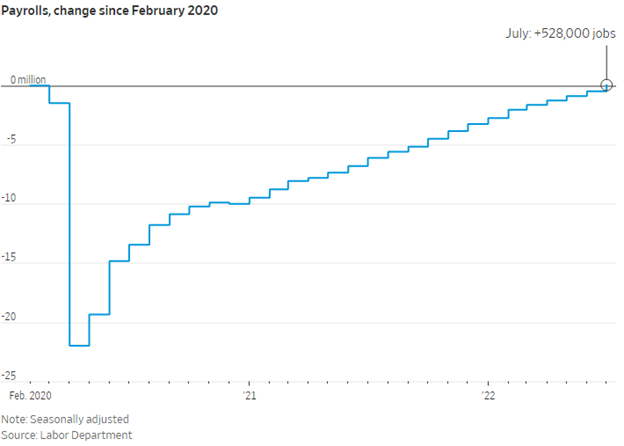The July jobs report dropped today, revealing that the U.S. has added 528,000 new jobs, officially recovering the 22 million jobs that were lost at the beginning of the pandemic, reported the Wall Street Journal.
 .Image source: Wall Street Journal
.Image source: Wall Street Journal
Unemployment has also dropped again, to 3.5%, a low last experienced at the very beginning of 2020, pre-pandemic. The participation rate dropped in July from 62.2% in June to 62.1% in July as the labor market continues to feel the losses of 623,000 workers overall, creating sustained wage pressures as demand for workers remains high.
Wage growth is on the rise, coming in higher than analyst expectations at a 0.5% increase from June and up 5.2% over last year.
“From a Fed perspective, this report says, ‘let’s keep pressing on the policy brake’ because inflation is uncomfortably high,” Greg Daco, chief economist at EY-Parthenon, told WSJ.
As inflation persists, there is anticipation by some economists that more workers will be driven back to the workforce by the impact of higher prices on household budgets.
The Federal Reserve isn’t set to meet again until September which leaves room for one more round of monthly reports before having to decide on what kind of interest rate increase is necessary to tame persistent inflation, but for now, anticipation is high for another 75 basis points increase. Fed-funds futures are currently sitting at 67% odds of a 0.75% hike. On Thursday those odds were just 34%.
“The strength of today’s number leaves the base case assumption that the Fed would probably have to do another 75-bps (basis points) rate hike from here unless the CPI report shows some dramatic weakness, which seems highly unlikely at this point,” Rick Rieder, CIO of global fixed income at BlackRock Inc.’s and head of the BlackRock global allocation investment team, told MarketWatch.
Investing in International Quality Dividends With a Hedge
More challenging times look to be ahead for U.S. investors and it could be a good time to look to international investments for diversification opportunities. In a time of a strong U.S. dollar, currency rates can play a big role in reducing return potential but the WisdomTree International Hedged Quality Dividend Growth Fund (IHDG) offers exposure to dividend-paying companies in the developed world, excluding the U.S. and Canada, while hedging for currency fluctuations.
IHDG seeks to track the WisdomTree International Hedged Quality Dividend Growth Index which consists of dividend-paying companies that exhibit growth characteristics (ex U.S. and Canada), while simultaneously hedging against a basket of currencies. The index pulls from the top 300 companies (on average) within the WisdomTree International Equity Index that have the highest rank of quality and growth factors. Factors highlighted include long-term earnings growth expectations, return on equity, and return on assets.
The index weights companies by dividends paid over the last annual cycle, with heavier weight going to the companies with greater total dollar dividends, and each security is capped at a 5% weight in the fund while sectors and countries are capped at 20% (real estate is capped at 15%).
The currency hedge of the index means that there should be higher returns when the U.S. dollar is strong, compared to equivalent unhedged investments, and will be lower when the U.S. dollar is weaker. The fund utilizes forward currency contracts or futures contracts to offset the impact of foreign currencies.
The top sectors of the fund include health care at 20.82% allocation, industrials at 19.37%, consumer discretionary at 18.60%, materials at 17.55%, information technology at 11.01%, and many smaller sector allocations.
IHDG has an expense ratio of 0.58%.
For more news, information, and strategy, visit the Modern Alpha Channel.








